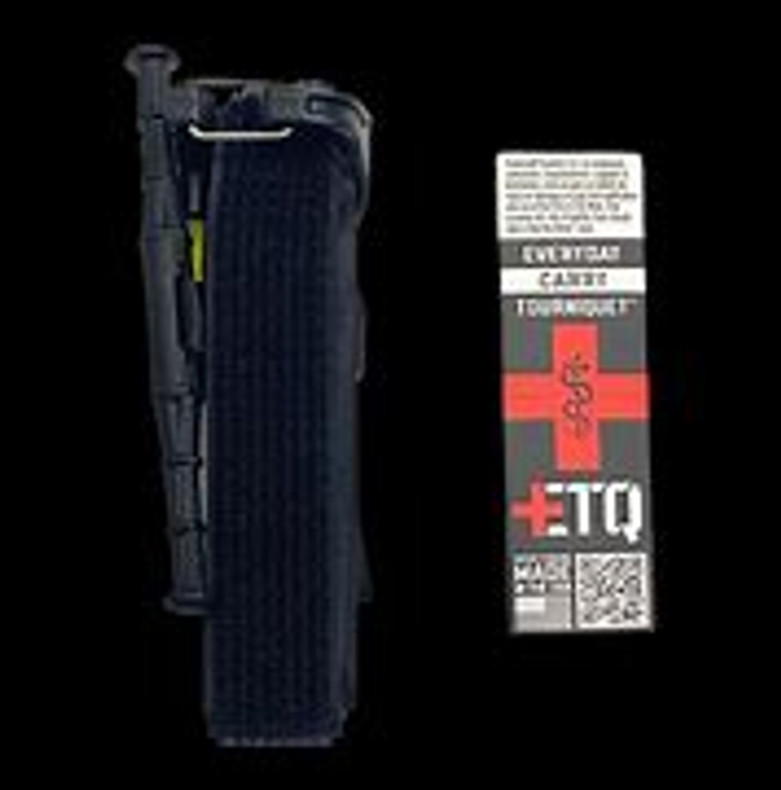The goal of a tourniquet is to restrict external blood flow to an injured limb and prevent life-threatening blood loss. It is only intended to buy time while you wait for emergency help. Tourniquets should be used only when all other options have failed. This includes elevating the limb above the heart and applying direct pressure to the wound for 15 minutes to allow a clot to form. If these efforts don't work, a tourniquet may be used as a last resort when the bleeding is uncontrollable, and the risk of death is high.
The fear with tourniquets is that limiting blood supply to the limb could result in amputation; however, it has been proven that a two-hour placement does not produce damaging outcomes. Typically, it takes about 4 to 6 hours to cause harm.
If there is no tourniquet on hand when an accident occurs, one can be made using a 2-3-inch-widepiece of material and a rod or stick that you twist to tighten it. A 2017 study on law enforcement tourniquet use published in Prehospital Disaster Medicine showed that improvised tourniquets failed six out of seven times.
Tourniquet use requires training because it isn't intuitive. Spending a few hours learning how to put on a tourniquet is not enough. It's not uncommon for lay providers to be taught how to use them and then forget the information a couple months later. Moreover, brains have difficulty processing under extreme pressure, and the tourniquet is most likely being used in a traumatic situation.
Snakestaff Systems has a solution. They understand that when shock sets in, it’s helpful to have simple instructions. That’s why they put them right on their Everyday Carry Tourniquet (ETQ). Anyone with a smartphone can Scan the QR code and access a step-by-step video tutorial.
Snakestaff is a company that makes American made trauma care products, including the ETQ. In addition, they collect clinical and real-world data on their products.
Features of the ETQ
Size: Measures 37.5” long by 1” wide- roughly the size of a small multi-tool, making it suitable for use on adults, children, canines or other small-limbed creatures. Fits in handgun mag pouches and kydex carriers.
Carabiner windlass lock: The patent-pending carabiner gate system is designed to keep the windlass from accidentally unwinding during transport. It auto-locks to hold the windlass securely in place and maintain consistent pressure for an extended amount of time. It also doubles as a mounting solution and can be attached to a key ring, backpack, belt loops or MOLLE.
Textured Windlass: A good grip is necessary when slippery fluids are involved.
Chemlight: Breaks upon application to help shine some light on the situation
Heavy-duty construction: Manufactured in the U.S.A. with durable materials that have been exhaustively tested in extreme conditions
Water repellent: Absorbs a minimal amount of water or sweat.
How to use a tourniquet:
- Source of bleeding- If possible, have the injured person lie down.
- Apply pressure- Apply direct pressure to the wound using an absorbent material for at least 15 minutes. That's how long it should take for blood to clot. If bleeding does not stop, then a tourniquet should be used.
- Inform patient- If the injured person is awake and alert, explain your intentions. They need to know that the process can be extremely painful but that the intention is to save their life.
- Position-Apply the tourniquet to bare skin. Place the tourniquet several inches above the injury closest to the heart. For example, if the injury is below the elbow, you will need to tie the tourniquet above the elbow. Never place the tourniquet directly on the joint
- Secure -Use a common square knot. This is done by tying the fabric as you would a shoelace but without making a bow.
- Windlass- Use a long, sturdy object as a windlass. Place the windlass on top of the square knot, then tie the loose ends of the tourniquet around it with another square knot.
- Tighten-Twist the windlass, keeping an eye on the bleeding. When the bleeding has stopped or is significantly reduced, secure the windlass by tying one or both ends to the injured person's arm or leg.
- Get help. Tourniquets should not be left in place for longer than two hours. Make note of the time you put the tourniquet by marking "T" with the date and time on an easy-to-see place.
- If the bleeding doesn't stop, try twisting the tourniquet more and see if that helps. If it doesn't, apply a second tourniquet immediately below the first one. Even if the first DO NOT remove the first tourniquet. Instead, place the second tourniquet, following steps 3 to 6, until the bleeding stops.
With the right materials and knowledge, anyone is capable of applying a tourniquet.

